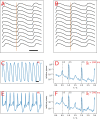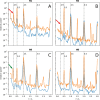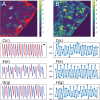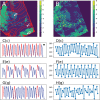This is a preprint.
Beyond Alternans: Detection of Higher-Order Periodicity in Ex-Vivo Human Ventricles Before Induction of Ventricular Fibrillation
- PMID: 37205562
- PMCID: PMC10187180
- DOI: 10.1101/2023.05.01.539003
Beyond Alternans: Detection of Higher-Order Periodicity in Ex-Vivo Human Ventricles Before Induction of Ventricular Fibrillation
Abstract
Background: Repolarization alternans, defined as period-2 oscillation in the repolarization phase of the action potentials, is one of the cornerstones of cardiac electrophysiology as it provides a mechanistic link between cellular dynamics and ventricular fibrillation (VF). Theoretically, higher-order periodicities (e.g., period-4, period-8,...) are expected but have very limited experimental evidence.
Methods: We studied explanted human hearts, obtained from the recipients of heart transplantation at the time of surgery, using optical mapping technique with transmembrane voltage-sensitive fluorescent dyes. The hearts were stimulated at an increasing rate until VF was induced. The signals recorded from the right ventricle endocardial surface just before the induction of VF and in the presence of 1:1 conduction were processed using the Principal Component Analysis and a combinatorial algorithm to detect and quantify higher-order dynamics.
Results: A prominent and statistically significant 1:4 peak (corresponding to period-4 dynamics) was seen in three of the six studied hearts. Local analysis revealed the spatiotemporal distribution of higher-order periods. Period-4 was localized to temporally stable islands. Higher-order oscillations (period-5, 6, and 8) were transient and primarily occurred in arcs parallel to the activation isochrones.
Discussion: We present evidence of higher-order periodicities and the co-existence of such regions with stable non-chaotic areas in ex-vivo human hearts before VF induction. This result is consistent with the period-doubling route to chaos as a possible mechanism of VF initiation, which complements the concordant to discordant alternans mechanism. The presence of higher-order regions may act as niduses of instability that can degenerate into chaotic fibrillation.
Conflict of interest statement
Disclosures Authors have no disclosure to make.
Figures





References
-
- Weiss JN, Qu Z, Chen P-S, Lin S-F, Karagueuzian HS, Hayashi H, Garfinkel A, Karma A. The dynamics of cardiac fibrillation. Circulation. 2005;112:1232–1240. - PubMed
-
- Fenton FH, Cherry EM, Hastings HM, Evans SJ. Multiple mechanisms of spiral wave breakup in a model of cardiac electrical activity. Chaos Woodbury N. 2002;12:852–892. - PubMed
-
- Jalife J. Ventricular Fibrillation: Mechanisms of Initiation and Maintenance. Annu. Rev. Physiol. 2000;62:25–50. - PubMed
-
- Strogatz SH. Nonlinear Dynamics and Chaos: With Applications to Physics, Biology, Chemistry, and Engineering. CRC Press; 2018.
Publication types
Grants and funding
LinkOut - more resources
Full Text Sources
